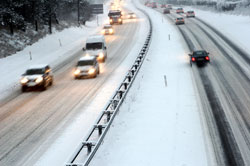What to Do If You Get Stuck in the Snow
Posted in Accident & Injury on December 3, 2013
 Winter is upon us and for much of the country, that means navigating treacherous roads. Before you head out, make sure you have a Winter Survival Kit stocked with the necessary supplies. Snow and ice, a collision, or even mechanical problems may cause you to become stuck in an inoperable vehicle. If you have been involved in an accident, contact a Cleveland car accident lawyer today.
Winter is upon us and for much of the country, that means navigating treacherous roads. Before you head out, make sure you have a Winter Survival Kit stocked with the necessary supplies. Snow and ice, a collision, or even mechanical problems may cause you to become stuck in an inoperable vehicle. If you have been involved in an accident, contact a Cleveland car accident lawyer today.
Don’t panic
In any emergency, it’s important to keep your cool. If your vehicle won’t move, you first need to assess the situation.
- Disengage the transmission. Shift the car into neutral and then park, but keep the engine running. If you have a manual transmission, put the car in neutral and apply the emergency brake.
- Turn on your hazard lights. It’s important to make your vehicle visible to approaching traffic.
- Get out safely. Put on a bright article of clothing and grab a flashlight. Exit the vehicle on the side opposite traffic.
- Check for damage. Before you attempt to get out of the snow, make sure your vehicle is safe to drive. Also, make certain the tail pipe is clear of snow or debris to prevent carbon monoxide poisoning.
- Be seen. Place flares and/or reflective triangles on the road to alert other drivers.
Getting out
If there is no significant structural damage to your car, you may want to try to get out of the snow yourself.
- Check tires. If the vehicle is up on an embankment or deep in a ditch, you’re probably going to need help.
- Clear the way. If there is not a lot of snow and the grade isn’t too steep or icy, you may be able to get yourself out by clearing the snow away from the tires. If you don’t have a shovel, try turning the steering wheel back and forth to push away the snow.
- Get traction. Kitty litter works well, just pour some in front of your power tires. If all else fails, you can place your floor mats in front of the power tires. Make sure no one is standing behind your car as you drive away, as the mats (or anything else under your tires) may kick out.
- Don’t rock the boat. In most vehicles with automatic transmission, rocking the vehicle excessively– moving forward and then reversing – is not recommended. Check your owner’s manual before attempting this maneuver, or you may do some serious damage.
- Easy does it. Straighten your steering wheel as much as you can, put your car in the lowest possible gear and gently press the accelerator. If the wheels begin to spin, back up and try again until you have enough room to get out.
Wait for help
If nothing works and you’re still stuck in the snow, get back inside and call for help from your cell phone. Roadside assistance may be available through, your insurance company, AAA membership and some car dealerships. If all else fails, or if you need to report an accident or require medical care, call 911 and report your situation.
- Stay put. Unless you can see a nearby indoor location where you know you can wait safely, it’s best to wait in your car until help arrives. It’s easy to become disoriented in bad weather, and wintery conditions increase your chance of being struck by another vehicle.
- Save gas. It is important to stay warm while waiting, but don’t run your vehicle the entire time, especially if you’re low on fuel. Tow trucks and other emergency vehicles may take hours to arrive due to increased need and snowy conditions. Run the engine to get warm, and then turn it off until you need it again.
For more tips on winter driving, read “Wintery conditions ahead” by Kyle W. Morrison.
Family Safety+Health, Vol. 70, No. 4, 2011-12.